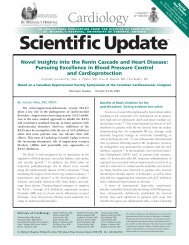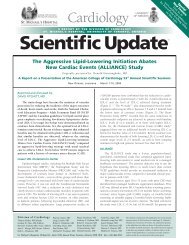Cardiac Surgical Management of Patients on Antiplatelet Agents
Cardiac Surgical Management of Patients on Antiplatelet Agents
Cardiac Surgical Management of Patients on Antiplatelet Agents
Create successful ePaper yourself
Turn your PDF publications into a flip-book with our unique Google optimized e-Paper software.
Figure 1: The mechanism <str<strong>on</strong>g>of</str<strong>on</strong>g> acti<strong>on</strong> <str<strong>on</strong>g>of</str<strong>on</strong>g> antiplatelet agents<br />
clopidogrel<br />
ticlopidine<br />
ADP<br />
Epinephrine<br />
Platelet receptors<br />
PAR-4<br />
Thrombin PAR-1<br />
ASA<br />
Platelet<br />
Endothelium<br />
vWF<br />
Adhesi<strong>on</strong><br />
Aggregati<strong>on</strong><br />
AA – Tx A GP IIb/IIIa GP IIb/IIIa<br />
GpIb<br />
PAR-4<br />
Exposed collagen<br />
abciximab<br />
eptifibatide<br />
tir<str<strong>on</strong>g>of</str<strong>on</strong>g>iban<br />
GpIb<br />
Platelet<br />
GpIb = V<strong>on</strong> Willebrand receptor; ADP = adenosine diphosphate;<br />
PAR-1 = protease-activated receptor 1<br />
PAR-4 = protease-activated receptor 4<br />
and the antiplatelet effect weaker than with other antiplatelet<br />
agents. These drugs are currently being investigated as an<br />
alternative or adjunctive to aspirin or thienopyridine therapy<br />
in patients with acute cor<strong>on</strong>ary syndromes undergoing<br />
percutaneous cor<strong>on</strong>ary interventi<strong>on</strong>.<br />
Thienopyridine anti-thrombotic agents<br />
There are 3 adenosine diphosphate (ADP) receptors <strong>on</strong><br />
the platelet surface. 5,6 Normal activati<strong>on</strong> <str<strong>on</strong>g>of</str<strong>on</strong>g> <strong>on</strong>e <str<strong>on</strong>g>of</str<strong>on</strong>g> the ADP<br />
receptors is critical for platelet activati<strong>on</strong> through inhibiti<strong>on</strong><br />
<str<strong>on</strong>g>of</str<strong>on</strong>g> adenylyate cyclase. In c<strong>on</strong>juncti<strong>on</strong> with other sec<strong>on</strong>dary<br />
measures generated from the activati<strong>on</strong> <str<strong>on</strong>g>of</str<strong>on</strong>g> the other surface<br />
receptors, the subsequent reducti<strong>on</strong> in cyclic adenosine<br />
m<strong>on</strong>ophosphate (AMP) in the platelet decreases platelet activati<strong>on</strong><br />
and allows expressi<strong>on</strong> <str<strong>on</strong>g>of</str<strong>on</strong>g> the glycoprotein (GP) IIb/IIIa<br />
receptor, which mediates platelet aggregati<strong>on</strong>. The thienopyridines<br />
– ticlopidine and clopidogrel – partially block this<br />
process and, thus, platelet activati<strong>on</strong> and aggregati<strong>on</strong>. They<br />
irreversibly antag<strong>on</strong>ize the Gi protein-linked ADP receptor<br />
and the lifespan <str<strong>on</strong>g>of</str<strong>on</strong>g> the effective platelet.<br />
Despite the apparent efficacy <str<strong>on</strong>g>of</str<strong>on</strong>g> ticlopidine, it is rarely<br />
used due to undesirable side-effects (eg, aplastic anemia,<br />
neutropenia, and thrombocytopenia purpura). Its efficacy<br />
has been compared to equipotent doses <str<strong>on</strong>g>of</str<strong>on</strong>g> the newer<br />
thienopyridine derivative, clopidogrel. Ticlopidine was<br />
shown to be inferior to clopidogrel in terms <str<strong>on</strong>g>of</str<strong>on</strong>g> its antiplatelet<br />
effect and protecti<strong>on</strong> from adverse myocardial outcomes. 7<br />
Clopidogrel bisulfate (Plavix ) is a thienopyridine prodrug<br />
that is metabolized by the cytochrome P-450 system to<br />
an activated compound that irreversibly binds the Gi-linked<br />
ADP receptor <strong>on</strong> the platelet’s surface, partially blocking<br />
the activati<strong>on</strong> by ADP. Clopidogrel has largely replaced ticlopidine<br />
in clinical practice due to a much lower incidence<br />
<str<strong>on</strong>g>of</str<strong>on</strong>g> adverse hematological side-effects (menti<strong>on</strong>ed above).<br />
However, there is raised awareness that the incidence <str<strong>on</strong>g>of</str<strong>on</strong>g> sideeffects<br />
with clopidogrel is probably higher than previously<br />
recognized.<br />
The effective half-life <str<strong>on</strong>g>of</str<strong>on</strong>g> the active metabolite is short and<br />
daily dosing is required to maintain the overall antiplatelet<br />
effect. 8<br />
While it is believed that the antiplatelet activity <str<strong>on</strong>g>of</str<strong>on</strong>g><br />
clopidogrel lasts approximately 7 days, as with aspirin, a<br />
transfusi<strong>on</strong> <str<strong>on</strong>g>of</str<strong>on</strong>g> fresh platelets can effectively reverse clopidogrel<br />
acti<strong>on</strong>, although circulating platelets, already bound<br />
to clopidogrel, remain inhibited. Like aspirin, clopidogrel is<br />
believed to affect forming platelets for the megakaryocyte.<br />
It has not yet been dem<strong>on</strong>strated how l<strong>on</strong>g this effect may be<br />
clinically relevant following the cessati<strong>on</strong> <str<strong>on</strong>g>of</str<strong>on</strong>g> clopidogrel<br />
therapy.<br />
Intravenous drugs<br />
Glycoprotein IIb/IIIa receptor inhibitors<br />
The GP IIb/IIIa receptor <strong>on</strong> the platelet surface is the<br />
base for the fibrin crosslinking resp<strong>on</strong>sible for platelet aggregati<strong>on</strong>.<br />
Unlike the thienopyridines that decrease effective<br />
aggregati<strong>on</strong> by 40%-50%, GP IIb/IIIa inhibitors directly<br />
block the fibrinogen receptor, preventing aggregati<strong>on</strong> altogether.<br />
Currently available GP IIb/IIIa inhibitors include<br />
abciximab (Reopro ), eptifibatide (Integrilin ), and tir<str<strong>on</strong>g>of</str<strong>on</strong>g>iban<br />
(Aggrastat ).<br />
Abciximab<br />
Abciximab is a human-murine chimeric m<strong>on</strong>ocl<strong>on</strong>al<br />
antibody fragment that binds to the n<strong>on</strong>specific GP IIb/IIIa<br />
receptor, preventing platelet aggregati<strong>on</strong>. The effective halflife<br />
is approximately 12 hours, with approximately 50% inhibiti<strong>on</strong><br />
<str<strong>on</strong>g>of</str<strong>on</strong>g> platelet functi<strong>on</strong> remaining 24 hours after stopping<br />
the infusi<strong>on</strong>. Once the infusi<strong>on</strong> is stopped, the anticoagulant<br />
effects <str<strong>on</strong>g>of</str<strong>on</strong>g> abciximab can be reversed by transfusi<strong>on</strong> with fresh<br />
platelets.<br />
Eptifibatide and tir<str<strong>on</strong>g>of</str<strong>on</strong>g>iban<br />
Eptifibatide is a cyclic heptapeptide based <strong>on</strong> the KGD<br />
amino acid sequence that selectively binds the GP IIb/IIIa<br />
receptor. The effective half-life is approximately 2 hours, with<br />
platelet functi<strong>on</strong> returning to >50% <str<strong>on</strong>g>of</str<strong>on</strong>g> normal within 4 hours<br />
after disc<strong>on</strong>tinuati<strong>on</strong>. Despite its short half-life, the effects <str<strong>on</strong>g>of</str<strong>on</strong>g><br />
eptifibatide are not reversible by the transfusi<strong>on</strong> <str<strong>on</strong>g>of</str<strong>on</strong>g> fresh platelets.<br />
Eptifibatide clearance is dependent <strong>on</strong> renal eliminati<strong>on</strong>.<br />
Tir<str<strong>on</strong>g>of</str<strong>on</strong>g>iban is a n<strong>on</strong>-peptide tyrosine derivative that binds<br />
selectively to the GP IIb/IIIa receptor. Like eptifibatide, its<br />
effective half-life is short at <strong>on</strong>ly 2 hours, and platelet functi<strong>on</strong><br />
returns to >50% <str<strong>on</strong>g>of</str<strong>on</strong>g> normal within 4 hours. These<br />
2 agents are not reversible with the transfusi<strong>on</strong> <str<strong>on</strong>g>of</str<strong>on</strong>g> platelets. 9<br />
Clearance depends up<strong>on</strong> both renal and biliary eliminati<strong>on</strong>.<br />
Cardiology<br />
Scientific Update




